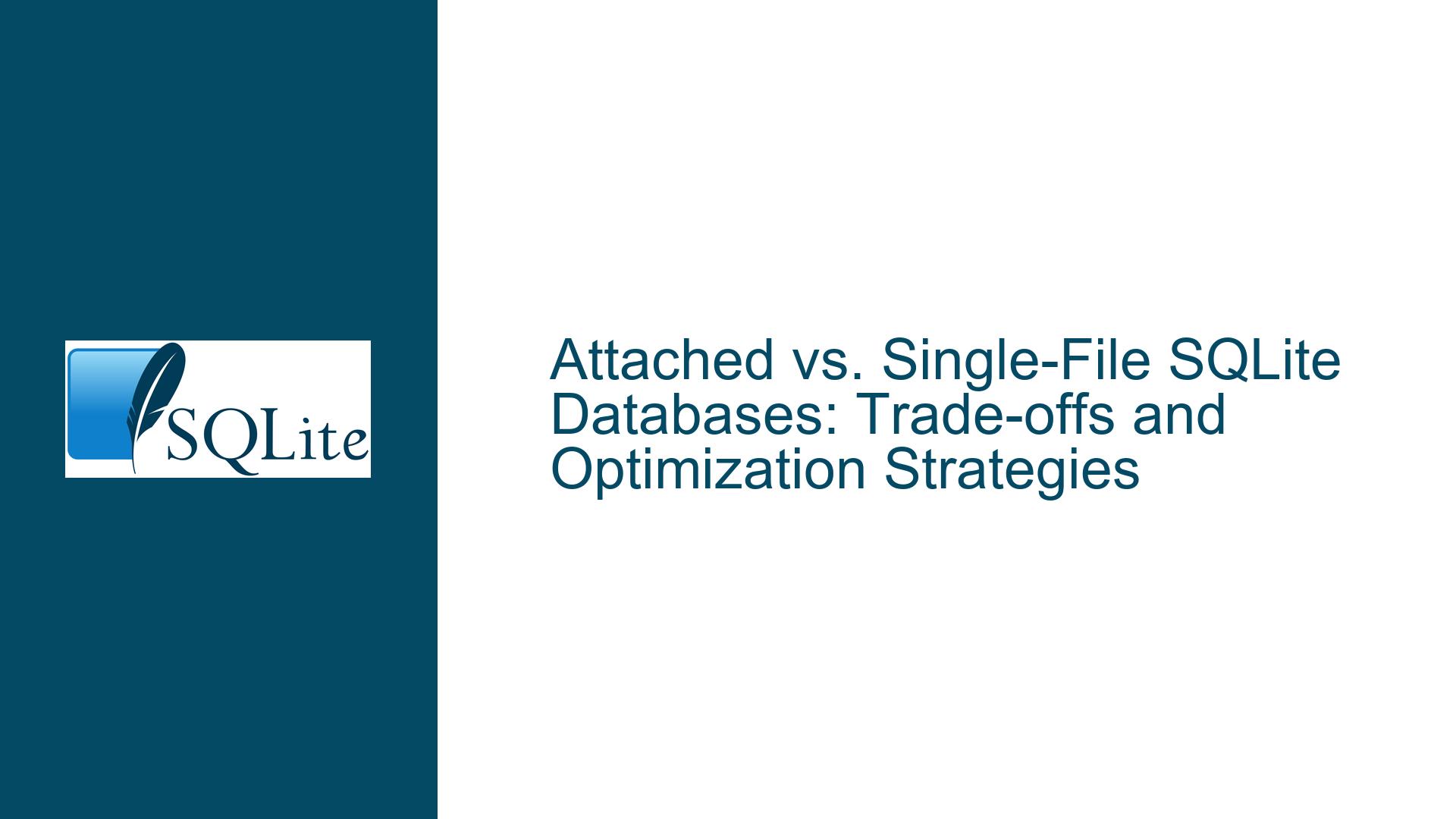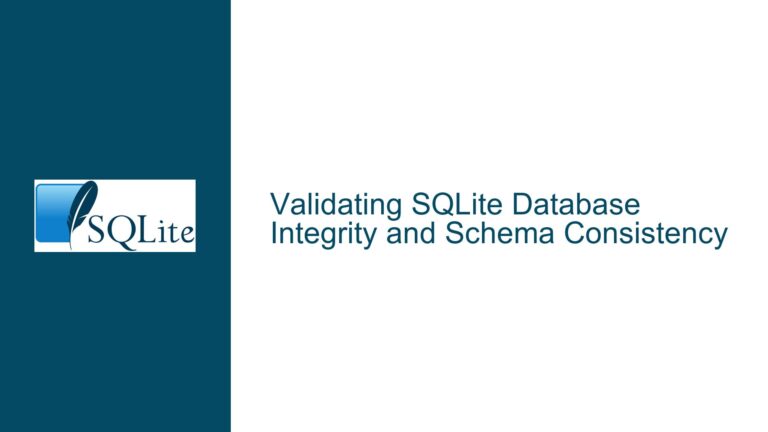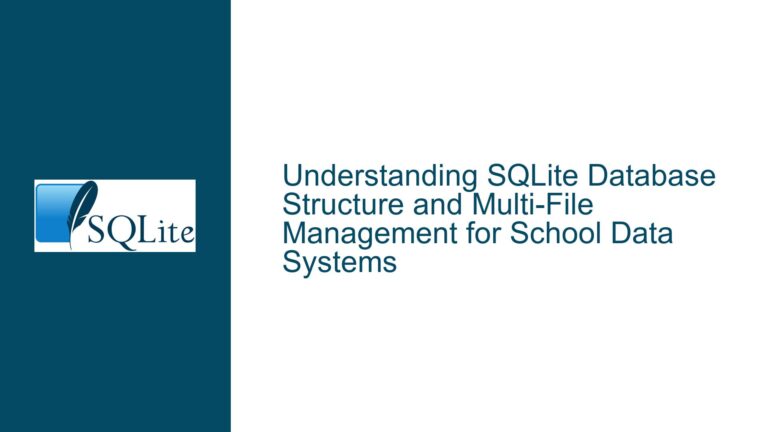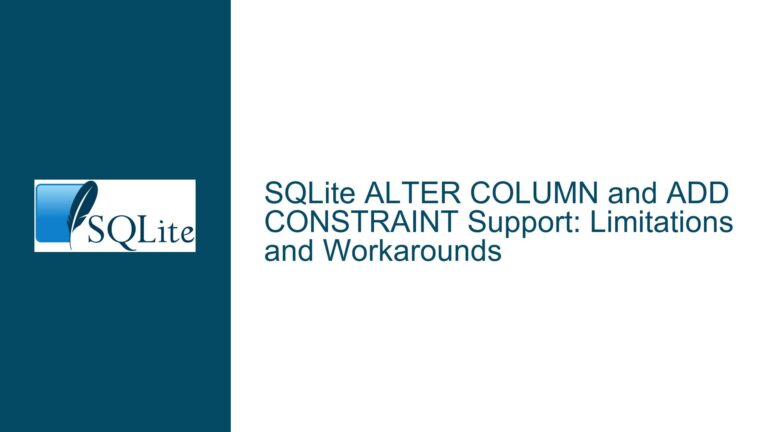Attached vs. Single-File SQLite Databases: Trade-offs and Optimization Strategies
Cross-Database Constraints and Query Optimization Limitations
The decision to split a SQLite database into multiple attached files introduces challenges in enforcing relational integrity and optimizing query execution. SQLite’s architecture treats each attached database as an independent entity, which means features like foreign key constraints, triggers, and views operate within the scope of a single database file. For example, a foreign key constraint defined in main.db cannot reference a table in attached.db. This limitation forces developers to implement application-level checks or redesign schemas to consolidate related tables into a single file.
The query planner’s ability to generate efficient execution plans is also impacted. SQLite’s ANALYZE command collects statistics about tables and indexes to guide the planner, but these statistics are stored in a sqlite_stat1 table within each database. When joining tables across attached databases, the planner lacks cross-database statistics, potentially leading to suboptimal index usage or join orders. For instance, a query joining main.users and attached.orders might underestimate the number of rows in orders if attached.db has not been analyzed recently.
Additionally, virtual tables like Full-Text Search (FTS) or R*Tree indexes are bound to their host database. Queries involving virtual tables in attached databases require explicit database qualifiers (e.g., attached.fts_table MATCH 'term'), complicating query construction. Developers must also ensure that extensions enabling virtual tables are loaded for each attached database, adding initialization overhead.
Transaction Atomicity and Connection Management Overheads
Atomic transactions are a cornerstone of SQLite’s reliability, but atomicity is limited to individual databases when using the ATTACH command. If a transaction modifies tables in both main.db and attached.db, a crash during commit might leave one database updated and the other unchanged. This behavior stems from how SQLite handles write-ahead logging (WAL): each database has its own WAL file, and there is no mechanism to coordinate commits across WALs. For example, an application transferring funds between main.accounts and attached.audit_log could end up with an inconsistent state if the system crashes mid-commit.
Connection management introduces further complexity. Opening multiple database files incurs file I/O and memory overhead, though this is negligible if connections are reused. However, frameworks like Node.js often encourage short-lived database connections for REST APIs, which can degrade performance. Each HTTP request opening/closing connections to main.db and attached.db amplifies latency, especially on high-traffic systems. For instance, a Node.js API handling 1,000 requests per second with per-request connection setup could spend significant cycles on file handles and memory allocation instead of query execution.
Connection pooling or long-lived connections mitigate this by reusing open database handles across requests. Developers must also consider file locking: concurrent writes to attached databases can trigger SQLITE_BUSY errors unless configured with busy_timeout or WAL mode. Tools like sqlite3_busy_handler() allow custom retry logic, but coordinating this across multiple attached databases requires careful implementation.
Data Segmentation Strategies and Backup Efficiency Considerations
Segmenting data into smaller databases simplifies incremental backups and schema evolution but complicates data cohesion. A 10GB database split into a 2GB static_data.db and 8GB dynamic_data.db allows faster rsync operations for static content. For example, nightly backups of dynamic_data.db transfer only changed blocks, reducing I/O and storage costs. However, restoring a consistent snapshot across multiple files requires external coordination, as SQLite lacks native multi-database snapshot isolation.
In-memory databases (:memory:) offer a hybrid approach. Attaching a read-only static_data.db to a :memory: instance copies its contents into RAM, accelerating read-heavy queries. This is ideal for reference tables like postal codes or product catalogs. However, writes to :memory: databases are volatile, so they’re unsuitable for dynamic data. Developers might combine this with ATTACH DATABASE 'file:static_data?mode=memory' AS static to load a file-backed database into memory, balancing speed and persistence.
Schema changes pose another challenge. Modifying a table in attached_v2.db while keeping main.db unchanged requires versioning the attached schema and updating the application to ATTACH the correct version. Migration scripts must handle cross-database dependencies, such as updating main.db views that reference attached_v1.db tables. Tools like sqlean’s sqlite-diff can automate schema comparisons, but testing is critical to avoid runtime errors from mismatched schemas.
To optimize performance, pre-analyze attached databases during off-peak hours using ANALYZE, and consider materialized views within a single database for frequently joined cross-database data. For example, a nightly job could refresh main.cached_orders from attached.orders, allowing daytime queries to avoid cross-database joins.
By weighing these factors—constraint enforcement, atomicity, connection overhead, and backup efficiency—developers can design systems that leverage SQLite’s flexibility while mitigating the pitfalls of multi-database architectures.






